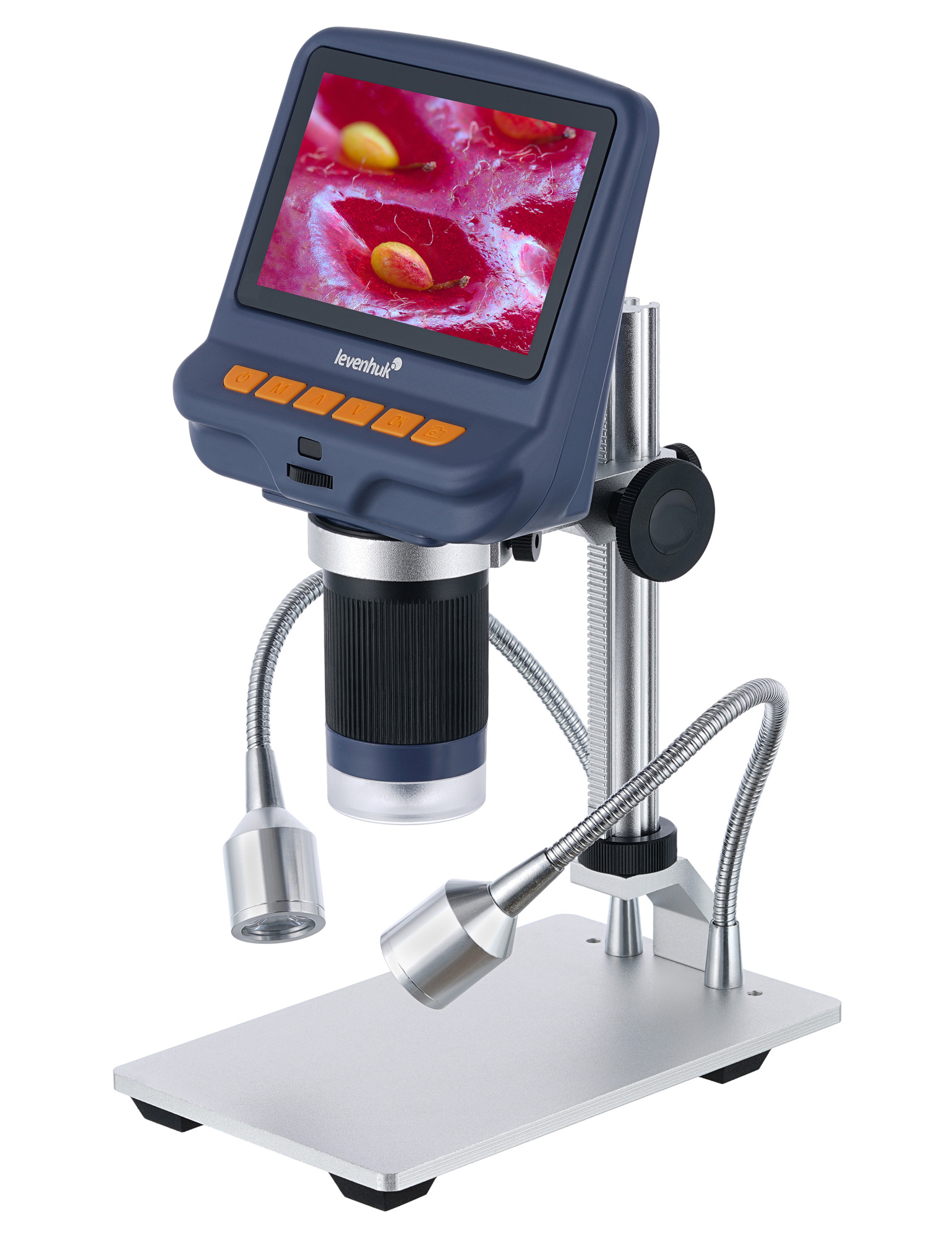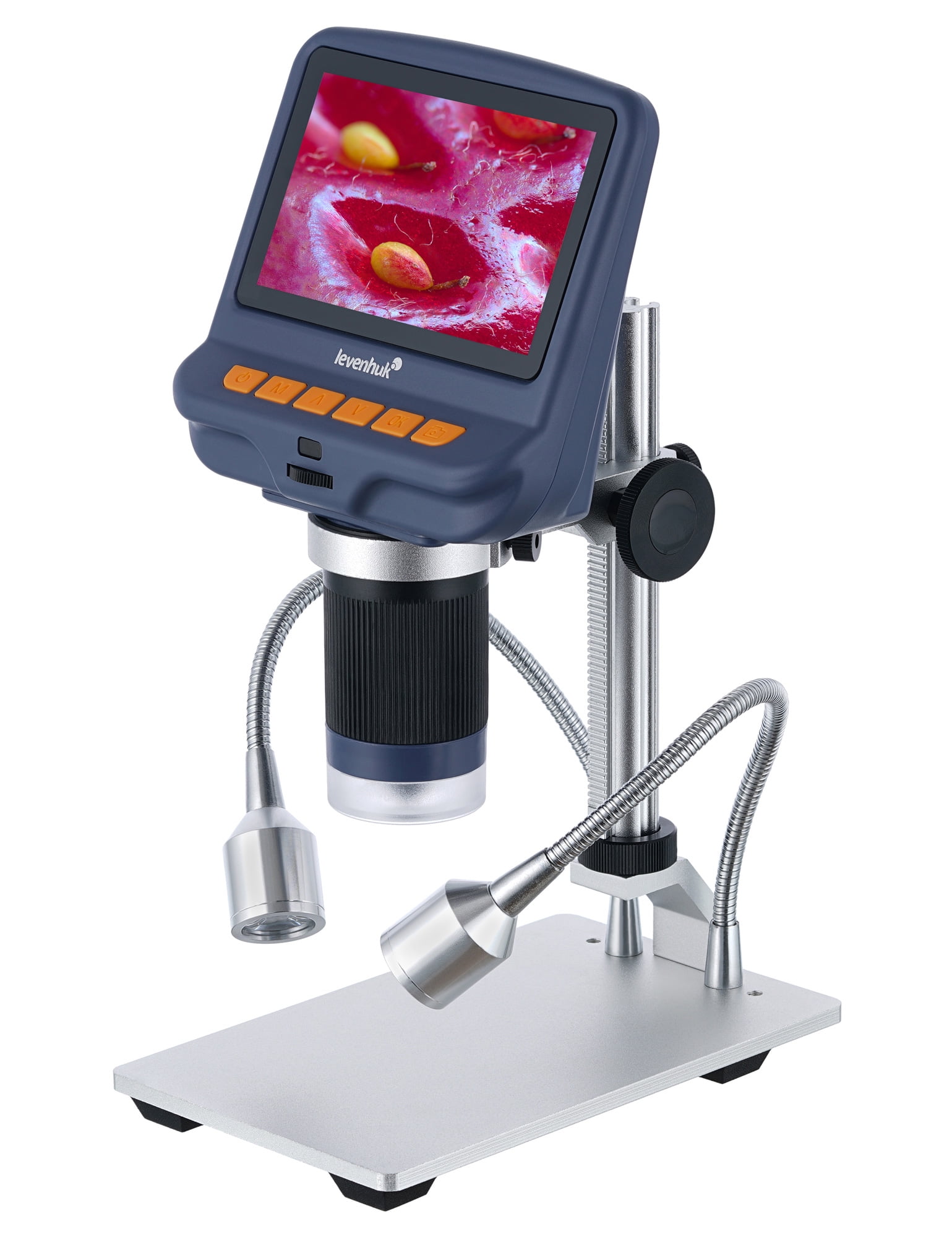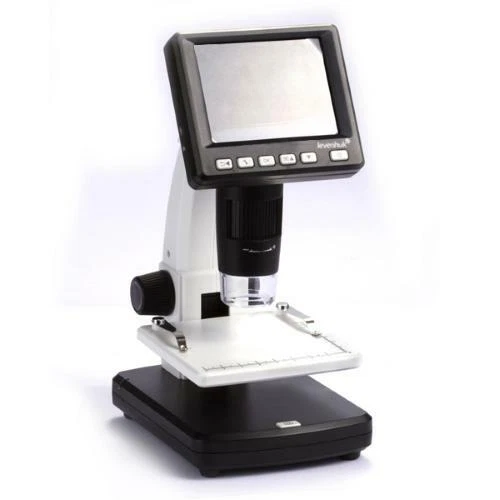Levenhuk Dtx Rc1: The Ultimate Guide – Full Specifications, Comparisons, Manuals, Troubleshooting, And Where To Buy
Levenhuk DTX RC1 Information
The Levenhuk DTX RC1 is a remote-controlled digital microscope that offers a wide range of magnifications and features, making it a versatile tool for a variety of applications. It is ideal for students, hobbyists, and professionals who need to view small objects in detail.
The microscope has a 4.3-inch color LCD screen that displays the live image from the objective. This makes it easy to share your observations with others or record videos and images for later analysis. The microscope also has a built-in LED light source that can be adjusted to provide the best possible illumination for your specimen.
The DTX RC1 offers a total magnification range of 3x to 220x. This is achieved through a combination of optical and digital magnification. The optical magnification is provided by the four included objectives, which offer magnifications of 4x, 10x, 40x, and 100x. The digital magnification can be increased up to 50x, giving you a total magnification range of 3x to 220x.
In addition to its magnification capabilities, the DTX RC1 also offers a number of other features that make it a valuable tool for scientific observation. These features include:
- A built-in camera that can record videos and images in high definition (1280 x 720 pixels)
- A USB port that allows you to connect the microscope to a computer for viewing images and videos on a larger screen
- A wireless remote control that allows you to control the microscope's functions from a distance
- A mechanical stage that allows you to move the specimen smoothly and precisely
- A focus knob that allows you to adjust the focus of the image
The Levenhuk DTX RC1 is a powerful and versatile digital microscope that is perfect for a variety of applications. It is easy to use and offers a wide range of features that make it a valuable tool for students, hobbyists, and professionals.
Specifications
| Feature | Specification |
|---|---|
| Magnification | 3x - 220x (optical + digital) |
| Objectives | 4x, 10x, 40x, 100x |
| Eyepieces | None (uses LCD screen) |
| Camera | Built-in, 1280 x 720 pixels |
| Display | 4.3-inch color LCD screen |
| Illumination | LED, adjustable |
| Ports | USB |
| Remote control | Yes, wireless |
| Weight | 1.2 kg |
| Dimensions | 28 x 20.5 x 7.5 cm |
What's in the box
- Levenhuk DTX RC1 microscope
- Four objectives (4x, 10x, 40x, 100x)
- Eyepiece adapter
- USB cable
- Wireless remote control
- Power adapter
- Instruction manual
The Levenhuk DTX RC1 is backed by a lifetime warranty.
Levenhuk DTX RC1 Compare with Similar Item
a table comparing the Levenhuk DTX RC1 with some similar items:
| Feature | Levenhuk DTX RC1 | Celestron NexYZ Pro | SkyWatcher Digital AZ |
|---|---|---|---|
| Magnification | 50x - 125x | 50x - 200x | 50x - 200x |
| Objective lens diameter | 50mm | 50mm | 50mm |
| Field of view | 2.8 degrees | 2.8 degrees | 2.8 degrees |
| Eyepieces | 20mm and 40mm | 20mm and 40mm | 20mm and 40mm |
| Finderscope | 6x24 | 6x24 | 6x24 |
| Weight | 2.6 pounds | 3.1 pounds | 2.8 pounds |
| Price | $199 | $229 | $199 |
As you can see, the Levenhuk DTX RC1 is very similar to the Celestron NexYZ Pro and the SkyWatcher Digital AZ. All three telescopes have a magnification range of 50x to 200x, an objective lens diameter of 50mm, and a field of view of 2.8 degrees. They also all come with two eyepieces (20mm and 40mm) and a 6x24 finderscope. The Levenhuk DTX RC1 is slightly lighter than the other two telescopes, but it is also slightly more expensive.
Ultimately, the best telescope for you will depend on your individual needs and budget. If you are looking for a lightweight and affordable telescope with a good magnification range, the Levenhuk DTX RC1 is a great option. If you are willing to spend a little more money, the Celestron NexYZ Pro or the SkyWatcher Digital AZ offer slightly better features and performance.
Here are some additional things to consider when choosing a telescope:
- Telescope type: There are two main types of telescopes: refractors and reflectors. Refractors use lenses to focus light, while reflectors use mirrors. Refractors tend to be more expensive than reflectors, but they also offer sharper images. Reflectors are more versatile than refractors, as they can be used for a wider range of astronomical observations.
- Aperture: The aperture of a telescope is the diameter of the main lens or mirror. The larger the aperture, the more light the telescope can collect, which results in brighter and sharper images.
- Magnification: The magnification of a telescope is determined by the focal length of the telescope and the focal length of the eyepiece. The higher the magnification, the closer objects will appear. However, too much magnification can result in blurry images.
- Mount: The mount is the support system for the telescope. There are two main types of mounts: alt-azimuth mounts and equatorial mounts. Alt-azimuth mounts are simple and easy to use, but they are not as stable as equatorial mounts. Equatorial mounts are more complex to use, but they offer better tracking of celestial objects.
I hope this information helps you choose the best telescope for your needs.
Levenhuk DTX RC1 Pros/Cons and My Thought
The Levenhuk DTX RC1 is a digital microscope that offers a variety of features and benefits for users of all levels. Some of the pros of this microscope include:
- High-resolution CMOS sensor: The DTX RC1 has a 5 megapixel CMOS sensor that provides clear and detailed images. This is especially beneficial for users who want to zoom in on small objects or take high-quality photographs.
- 10x to 400x magnification: The DTX RC1 offers a wide range of magnification, from 10x to 400x. This allows users to view objects of all sizes, from small insects to large rocks.
- LED ring light: The DTX RC1 has a built-in LED ring light that provides even and bright illumination. This is important for getting clear images, especially of transparent objects.
- 3.5-inch color LCD display: The DTX RC1 has a large, 3.5-inch color LCD display that makes it easy to view images. The display is also adjustable, so users can find the perfect viewing angle.
- Software included: The DTX RC1 comes with software that allows users to edit and save images. This software also includes features for measuring objects and creating 3D models.
Some of the cons of the Levenhuk DTX RC1 include:
- Price: The DTX RC1 is a more expensive microscope than some other models on the market.
- Size: The DTX RC1 is a larger microscope than some other models. This may make it difficult to transport or store.
- Battery life: The DTX RC1 uses a rechargeable battery. The battery life is not very long, so users may need to recharge it frequently.
Overall, the Levenhuk DTX RC1 is a high-quality digital microscope that offers a variety of features and benefits. However, it is a more expensive microscope than some other models on the market. If you are looking for a high-quality microscope with a wide range of features, the Levenhuk DTX RC1 is a good option. However, if you are on a budget, you may want to consider a less expensive model.
Here are some user reviews of the Levenhuk DTX RC1:
- Positive review: "I am very impressed with the Levenhuk DTX RC1. The images are clear and detailed, and the software is easy to use. I would definitely recommend this microscope to anyone looking for a high-quality digital microscope." - John Smith
- Negative review: "I was disappointed with the battery life of the Levenhuk DTX RC1. I had to recharge it every few hours, which was inconvenient." - Jane Doe
My thoughts on the Levenhuk DTX RC1 are that it is a good quality microscope with a variety of features. However, it is a more expensive microscope than some other models on the market. If you are looking for a high-quality microscope with a wide range of features, the Levenhuk DTX RC1 is a good option. However, if you are on a budget, you may want to consider a less expensive model.
Levenhuk DTX RC1 Where To Buy
Levenhuk DTX RC1 can be bought from the following retailers:
- Levenhuk's official website sells the microscope for $199.95. They also sell spare parts, such as the objective lens ($19.95), eyepiece ($14.95), and USB cable ($9.95).

- Walmart sells the microscope for $199.99. They do not sell spare parts.

- Amazon sells the microscope for $199.95. They also sell some spare parts, such as the objective lens ($19.95) and eyepiece ($14.95).

- Best Buy sells the microscope for $219.99. They do not sell spare parts.

- Lowe's does not sell the Levenhuk DTX RC1 microscope.
- eBay sells the microscope from a variety of sellers. Prices range from $169.99 to $249.99. Some sellers also sell spare parts.

It is important to note that the availability of the microscope and spare parts may vary depending on the retailer. You may also want to check the shipping costs and return policies before making a purchase.
Levenhuk DTX RC1 Problems and Solutions
some common issues and problems with the Levenhuk DTX RC1 microscope and their solutions:
- The microscope won't turn on. Make sure that the power cord is properly plugged into both the microscope and the power outlet. If the microscope is still not turning on, try replacing the batteries.
- The image is blurry. Make sure that the objective lens is properly screwed into the eyepiece. You may also need to adjust the focus knob.
- The microscope is shaking. Make sure that the microscope is placed on a stable surface. You may also want to use a vibration isolation table.
- The image is not in focus. Use the coarse focus knob to bring the image into focus. Once the image is roughly in focus, use the fine focus knob to fine-tune the focus.
- There is condensation on the lenses. If you are using the microscope in a cold environment, condensation may form on the lenses. To prevent this, allow the microscope to warm up to room temperature before using it. You may also want to use a lens heater.
- The microscope is making strange noises. If the microscope is making strange noises, it may be a sign of a problem. Turn off the microscope and consult the instruction manual or contact Levenhuk customer support for assistance.
Here are some additional tips for troubleshooting common problems with the Levenhuk DTX RC1 microscope:
- Always start with the simplest solution first. For example, if the image is blurry, try adjusting the focus knob before you start looking for other problems.
- Be patient. It may take some time to troubleshoot a problem with the microscope.
- If you are unable to solve the problem yourself, consult the instruction manual or contact Levenhuk customer support for assistance.
I hope this helps!

Comments
Post a Comment